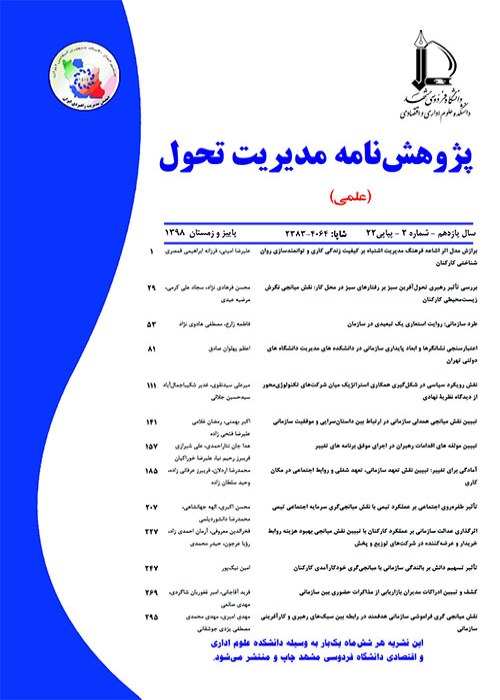Examining the Impact of Strategic Leadership on Sustainable Competitive Advantage Mediated by Innovation Ambidexterity and Human Capital
Author(s):
Article Type:
Research/Original Article (دارای رتبه معتبر)
Abstract:
1-
2- THEORETICAL FRAMEWORK
Strategic leadership is the process of directing strategic plans and ensuring their satisfactory implementation, the objective of which is to succeed the organization in the long term. Leadership is considered one of the most important duties and roles of a manager. The importance of this task is high such that some scholars relate a manager's success to their ability to direct human resources. Human capital is a set of management skills such as creativity, problem-solving ability, and leadership embedded in the organization's employees. Human capital is a constitution of all potential and actual capabilities of employees that can be strengthened with proper investment. The ability of an organization to simultaneously discover innovative opportunities and implement innovation is a contradiction called innovation ambidexterity. Sustainable competitive advantage is defined as higher-than-normal returns associated with the performance and expectations of the capital market.
3-
4- RESULTS &
5- CONCLUSIONS & SUGGESTIONS
Practical and research implications are presented as follows.
It is suggested that enterprises hold a workshop for their managers to teach important points of strategic leadership and the art of influencing others. It is suggested that managers redefine the organizational goals and vision based on the current conditions of the environment, redesign the organizational structure according to new goals and conditions, organize training programs for employees to develop their human capital, design programs to improve moral values in the organization; enhance the organizational culture by arranging individual and group counseling meetings for employees and managers.
It is suggested that managers establish a research and development center, establish a closer and more organized relationship with university professors in order to use new knowledge and transform it into new technologies, and establish an industry-university liaison office. Company managers are advised to give priority to hiring and employing creative and innovative employees. Also, for any innovation presented by the employees that leads to the creation of a creative product or service, allocate a percentage of the sales profit to encourage them.
Considering the dramatic difference between the enterprises in the growth center regarding age, market size, type of activity, growth stage, number of employees, and other factors, it is suggested to approach them differently and study these enterprises in separate and more specialized categories.
Since several factors may influence the relationship between strategic leadership and sustainable competitive advantage, according to a review of the research literature as well as field observations, it is suggested to consider mediators such as knowledge capital, organizational culture, brand reputation, strategic flexibility, business intelligence, etc.
The research reached a big difference between humanities and non-humanities growth center companies (including engineering, agriculture, basic sciences, veterinary medicine, and sports sciences). Accordingly, it is suggested to conduct separate research on them for a more detailed investigation.
INTRODUCTION
The current research aims to investigate the effect of strategic leadership on the ability to create sustainable competitive advantage. Moreover, it examines the mediating role of human capital and innovation ambidexterity. The target population of the research is enterprises operating in the growth center of Ferdowsi University of Mashhad.2- THEORETICAL FRAMEWORK
Strategic leadership is the process of directing strategic plans and ensuring their satisfactory implementation, the objective of which is to succeed the organization in the long term. Leadership is considered one of the most important duties and roles of a manager. The importance of this task is high such that some scholars relate a manager's success to their ability to direct human resources. Human capital is a set of management skills such as creativity, problem-solving ability, and leadership embedded in the organization's employees. Human capital is a constitution of all potential and actual capabilities of employees that can be strengthened with proper investment. The ability of an organization to simultaneously discover innovative opportunities and implement innovation is a contradiction called innovation ambidexterity. Sustainable competitive advantage is defined as higher-than-normal returns associated with the performance and expectations of the capital market.
3-
METHODOLOGY
The current research is a positivist study in terms of paradigm, inductive in terms of approach, practical in terms of purpose, descriptive-analytical in terms of method, and quantitative in terms of data and research design. The target population of this research is comprised of 110 enterprises at the growth center of Ferdowsi University of Mashhad, from which 86 were sampled with the simple random method. Thus, its level of analysis is organizational. Needed data was collected by distributing a written questionnaire, whose reliability was affirmed using Cronbach's alpha and composite reliability coefficient. To assess the questionnaire's validity, a confirmatory factor analysis was conducted and evaluated in terms of both convergence and divergence. The collected data was analyzed by conducting a structural equation modeling in SmartPLS software.4- RESULTS &
DISCUSSION
Research results confirmed all its hypotheses and indicated that strategic leadership has a direct positive significant effect on sustainable competitive advantage. Additionally, it affects sustainable competitive advantage indirectly through human capital and innovation ambidexterity.5- CONCLUSIONS & SUGGESTIONS
Practical and research implications are presented as follows.
It is suggested that enterprises hold a workshop for their managers to teach important points of strategic leadership and the art of influencing others. It is suggested that managers redefine the organizational goals and vision based on the current conditions of the environment, redesign the organizational structure according to new goals and conditions, organize training programs for employees to develop their human capital, design programs to improve moral values in the organization; enhance the organizational culture by arranging individual and group counseling meetings for employees and managers.
It is suggested that managers establish a research and development center, establish a closer and more organized relationship with university professors in order to use new knowledge and transform it into new technologies, and establish an industry-university liaison office. Company managers are advised to give priority to hiring and employing creative and innovative employees. Also, for any innovation presented by the employees that leads to the creation of a creative product or service, allocate a percentage of the sales profit to encourage them.
Considering the dramatic difference between the enterprises in the growth center regarding age, market size, type of activity, growth stage, number of employees, and other factors, it is suggested to approach them differently and study these enterprises in separate and more specialized categories.
Since several factors may influence the relationship between strategic leadership and sustainable competitive advantage, according to a review of the research literature as well as field observations, it is suggested to consider mediators such as knowledge capital, organizational culture, brand reputation, strategic flexibility, business intelligence, etc.
The research reached a big difference between humanities and non-humanities growth center companies (including engineering, agriculture, basic sciences, veterinary medicine, and sports sciences). Accordingly, it is suggested to conduct separate research on them for a more detailed investigation.
Keywords:
Language:
Persian
Published:
Transformation Managemet Journal, Volume:15 Issue: 1, 2024
Pages:
99 to 125
magiran.com/p2679592
دانلود و مطالعه متن این مقاله با یکی از روشهای زیر امکان پذیر است:
اشتراک شخصی
با عضویت و پرداخت آنلاین حق اشتراک یکساله به مبلغ 1,390,000ريال میتوانید 70 عنوان مطلب دانلود کنید!
اشتراک سازمانی
به کتابخانه دانشگاه یا محل کار خود پیشنهاد کنید تا اشتراک سازمانی این پایگاه را برای دسترسی نامحدود همه کاربران به متن مطالب تهیه نمایند!
توجه!
- حق عضویت دریافتی صرف حمایت از نشریات عضو و نگهداری، تکمیل و توسعه مگیران میشود.
- پرداخت حق اشتراک و دانلود مقالات اجازه بازنشر آن در سایر رسانههای چاپی و دیجیتال را به کاربر نمیدهد.
In order to view content subscription is required
Personal subscription
Subscribe magiran.com for 70 € euros via PayPal and download 70 articles during a year.
Organization subscription
Please contact us to subscribe your university or library for unlimited access!




